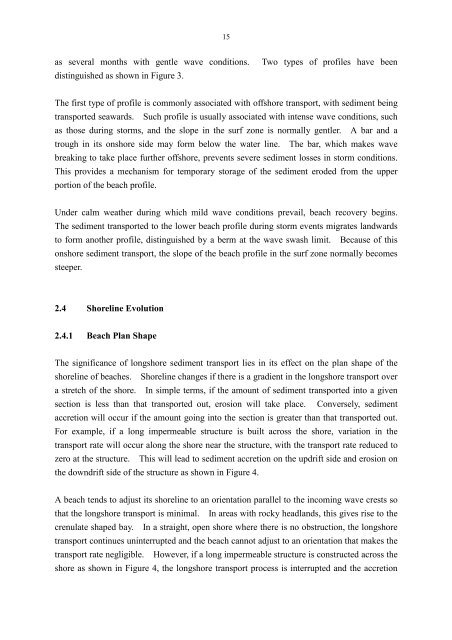PORT WORKS DESIGN MANUAL PART 5 Guide to Design of ...
PORT WORKS DESIGN MANUAL PART 5 Guide to Design of ...
PORT WORKS DESIGN MANUAL PART 5 Guide to Design of ...
Create successful ePaper yourself
Turn your PDF publications into a flip-book with our unique Google optimized e-Paper software.
15<br />
as several months with gentle wave conditions. Two types <strong>of</strong> pr<strong>of</strong>iles have been<br />
distinguished as shown in Figure 3.<br />
The first type <strong>of</strong> pr<strong>of</strong>ile is commonly associated with <strong>of</strong>fshore transport, with sediment being<br />
transported seawards. Such pr<strong>of</strong>ile is usually associated with intense wave conditions, such<br />
as those during s<strong>to</strong>rms, and the slope in the surf zone is normally gentler. A bar and a<br />
trough in its onshore side may form below the water line. The bar, which makes wave<br />
breaking <strong>to</strong> take place further <strong>of</strong>fshore, prevents severe sediment losses in s<strong>to</strong>rm conditions.<br />
This provides a mechanism for temporary s<strong>to</strong>rage <strong>of</strong> the sediment eroded from the upper<br />
portion <strong>of</strong> the beach pr<strong>of</strong>ile.<br />
Under calm weather during which mild wave conditions prevail, beach recovery begins.<br />
The sediment transported <strong>to</strong> the lower beach pr<strong>of</strong>ile during s<strong>to</strong>rm events migrates landwards<br />
<strong>to</strong> form another pr<strong>of</strong>ile, distinguished by a berm at the wave swash limit. Because <strong>of</strong> this<br />
onshore sediment transport, the slope <strong>of</strong> the beach pr<strong>of</strong>ile in the surf zone normally becomes<br />
steeper.<br />
2.4 Shoreline Evolution<br />
2.4.1 Beach Plan Shape<br />
The significance <strong>of</strong> longshore sediment transport lies in its effect on the plan shape <strong>of</strong> the<br />
shoreline <strong>of</strong> beaches. Shoreline changes if there is a gradient in the longshore transport over<br />
a stretch <strong>of</strong> the shore. In simple terms, if the amount <strong>of</strong> sediment transported in<strong>to</strong> a given<br />
section is less than that transported out, erosion will take place. Conversely, sediment<br />
accretion will occur if the amount going in<strong>to</strong> the section is greater than that transported out.<br />
For example, if a long impermeable structure is built across the shore, variation in the<br />
transport rate will occur along the shore near the structure, with the transport rate reduced <strong>to</strong><br />
zero at the structure. This will lead <strong>to</strong> sediment accretion on the updrift side and erosion on<br />
the downdrift side <strong>of</strong> the structure as shown in Figure 4.<br />
A beach tends <strong>to</strong> adjust its shoreline <strong>to</strong> an orientation parallel <strong>to</strong> the incoming wave crests so<br />
that the longshore transport is minimal. In areas with rocky headlands, this gives rise <strong>to</strong> the<br />
crenulate shaped bay. In a straight, open shore where there is no obstruction, the longshore<br />
transport continues uninterrupted and the beach cannot adjust <strong>to</strong> an orientation that makes the<br />
transport rate negligible. However, if a long impermeable structure is constructed across the<br />
shore as shown in Figure 4, the longshore transport process is interrupted and the accretion

















